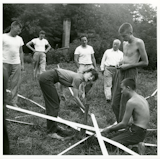Its triangulation evokes a playful spirit of Bucky Fuller, as does its idea of shelter temporality -- which can be paralleled to Fuller’s ‘Lightful Houses’ or even his Dymaxion House and Car in the 1930s. According to N55, the Walking House was directly inspired by the traditional nomadic culture and horse carriages of the Romani people.
Geodesic domes were first popularized by R. Buckminster Fuller in the mid-twentieth century, but the extremely strong and stable structures have since been developed into sustainable, wind-resistant models. Oregon Dome produces wind and hurricane resistant geodesic dome kits in thousands of plans, sizes, and shapes. Each can easily be built by the customers themselves, no special equipment necessary.
"Make the world work, for 100% of humanity, in the shortest possible time, through spontaneous cooperation, without ecological offense or the disadvantage of anyone." While Fuller’s ultimate goal was audacious, the idea of a real-time simulation in the ‘60s, accessible to before widespread access to computing, was just somewhat less ambitious. Fuller’s game—so-called to be accessible to everyone—was a further expansion of his Spaceship Earth philosophy, and is currently being utilized as a model by the O.S. Earth Institute. (Pictured: Bucky's Time cover from 1964.)
The March 1, 1943 issue of Life magazine included one of publishing’s more intriguing fold-outs; the first example of Buckminster Fuller’s Dymaxion Map. Less outlandish today, in an age of Feltron and infographic overload, Fuller’s fold-out projection was an outlier that raised serious philosophical and political points. With no fixed direction and less distortion than then-current maps, the Dymaxion Map sought to do away with judgements based on size and position, and make the underlying point that we’re all together on spaceship Earth. Fuller deliberately presented humanity as "one island, in one ocean," so we could better face our common problems together.
Our Fuller cocktail table's sculptural shape is inspired by mid-century designs. Thick slabs of wood are carved by master woodworkers into fluid shapes with rounded bull-nose edges, giving Fuller a stunning silhouette. #furniture #madeinamerica
The ends of the longhouse structures feature large glass windows and the very top one opens onto a balcony that overlooks the Vitra campus. The white dome was designed by Buckminster Fuller and built in Detroit, Michigan, in 1978 before going up for sale in 2000, at which time Vitra purchased it and shipped it to Weil-am-Rhein. Frank Gehry designed the factory in the background as well as entrance gate and building that houses the Vitra Design Museum.
German engineer Walter Bauersfeld can take credit for erecting the first geodesic dome in 1926, a replica of the night sky that glowed with nearly 5,000 stars. But Fuller’s work popularizing these hyper-efficient structures led to their mass adaptation around the world—more than 300,000 exist at last count. During a teaching stint at Black Mountain College from 1948-1949, Fuller refined synergetic geometry and the dome concept, utilizing a spherical arrangement of triangles to cover more space with less material. Bucky was soon creating domes for the U.S. military (covering, among other things, radar station in the Arctic Circle) and the Ford Motor Company, and popularizing the concept with worldwide audiences at the 1954 Milan Triennale.
To help showcase America’s achievements at the 1967 World’s Fair in Montreal (and potentially distract crowds from the UK pavilion, manned by hostesses sporting the newly popular miniskirt), the U.S. government recruited Buckminster Fuller to design a geodesic dome. The choice proved inspired; more than 5 million traveled to the glittering American pavilion, encased in a clear acrylic cover, to see myriad displays, such as Apollo spacecraft, While it proved eye-catching during the Expo, the cover also proved extremely flammable; a fire reduced the dome to a mere steel skeleton in 1976. In a meaningful tribute to Fuller’s legacy, the site has since been turned into an environmental museum.
39 more photos



































